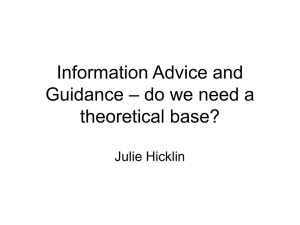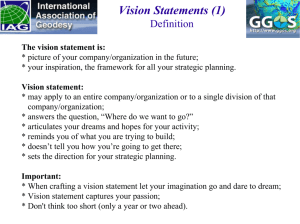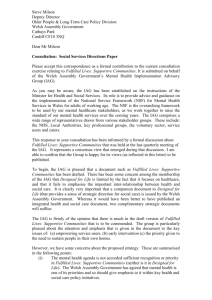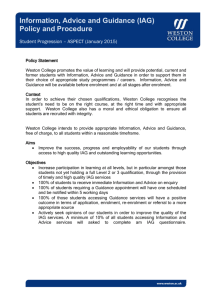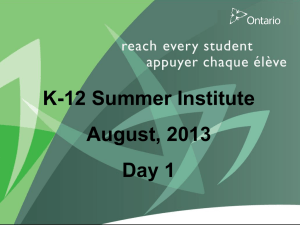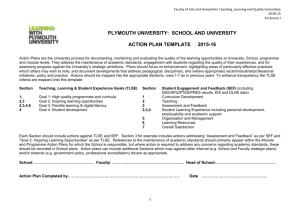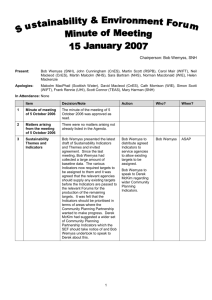Diagnostic Tool for School Leaders
advertisement
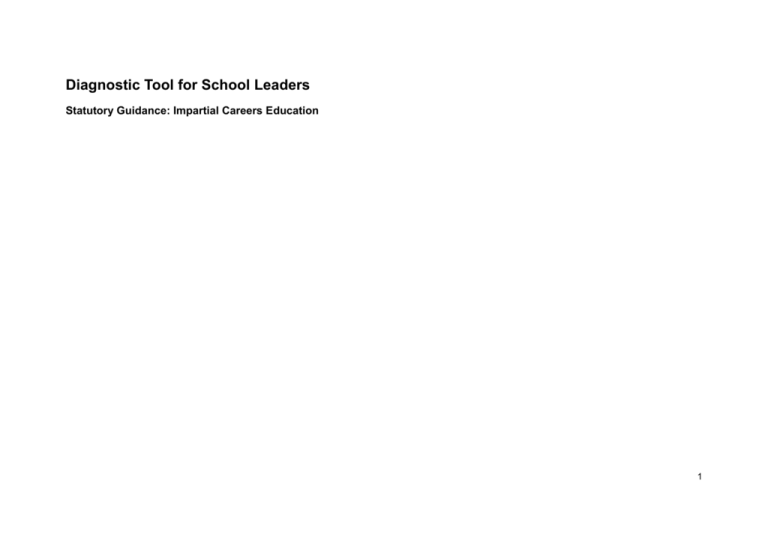
Diagnostic Tool for School Leaders Statutory Guidance: Impartial Careers Education 1 Introduction The statutory guidance on impartial careers education (www.dcsf.gov.uk/everychildmatters/earlyyears) emphasises the importance of conducting regular internal reviews of the quality of careers education provision. This tool will help you to identify strengths, weaknesses and areas for improvement in current arrangements. The examples under each heading illustrate best practice. You can use the outcomes to inform: your CE/IAG development and school improvement plans the Partnership Agreement between your school/PRU and the local Connexions service the completion of your SEF. The following sections of the SEF are referenced in the tool: Outcomes – A2.8, A2.10, A2.11 Provision – A3.1, A3.2, A3.3, A3.4 Leadership and management – A4.1, A4.2, A4.4, A4.5, A4.6 Compliance with statutory requirements – C19. 2 Diagnostic tool for school leaders - Impartial careers education RAG ratings: Green – good, Green/Amber – satisfactory, Amber/Red – Poor, Red – inadequate Active and committed leadership Senior leaders communicate the importance of CE/IAG to the whole staff and drive forward the school’s vision for CE/IAG with a strong focus on personalisation and long term progression. A member of the senior leadership team leads on CE/IAG, has the autonomy/resources to fulfil the leadership role and clear objectives with measurable targets for improvement linked to the school improvement plan. The careers co-ordinator/leader has the skills, knowledge and time to fulfil their responsibilities effectively. Whole school approach G GA AR R Evidence base/comments SEF Links A4.1, 4.2, 4.5 G GA AR R Evidence base/comments SEF Links High quality CE programme from Year 7 onwards delivers the Principles and provides young people with the Key Information on learning pathways. A2.10 Information about learning and work pathways is embedded in the wider curriculum. A4.2 Every pupil receives personalised IAG. There is an effective Partnership Agreement with Connexions. A3.1 to 3.4 3 Workforce development G GA AR R Evidence base/comments The school’s workforce development strategy includes CE/IAG. Staff have clearly defined roles and responsibilities with accountability through the performance management system. The Partnership Agreement with Connexions includes support for CPD. Training and support arrangements enable the careers co-ordinator/leader to perform effectively. Training and support arrangements enable staff providing personal tutoring and staff teaching careers education to acquire the knowledge and skills they need to perform effectively. All staff understand the statutory duties for CE/IAG, know how and where to refer young people for expert advice, and are up to date with changes in the 14-19 qualifications offer and learning and labour market opportunities. Helping parents/carers to support their children The school’s strategy for engaging parents includes CE/IAG. Parents/carers receive information about the services available to help their children make effective learning and career decisions – including Connexions and online services such as Connexions Direct, the local 14-19 Prospectus and Apprenticeship Vacancy Matching Service. SEF Links A2.10 A3.1 to 3.4 A4.2 G GA AR R Evidence base/comments SEF Links A2.10 A3.4 Parents/carers receive information and advice from those providing personal tutoring and others to help them understand their children’s options and support their decision making. Parents/carers are helped to explore possible learning A4.4, 4.6 4 destinations for their children. Embedding information about learning and work pathways into the wider curriculum Staff make effective use of work related contexts for learning. Subject studies include information about progression opportunities in learning and work that pupils can access through more advanced study. G GA AR R Evidence base/comments SEF Links A2.10 A3.3, 3.4 A4.2 Progress reviews from Year 7 onwards include discussion of aspirations and progression opportunities in learning and work. Experiential learning/engaging with the local business community Experiential learning makes an effective contribution to CE in KS3 and KS4. The school’s strategy for engaging employers includes CE/IAG and local employers and organisations such as the Education Business Partnership contribute to CE/IAG in KS3 and KS4. Curriculum delivery supports synergy between the curriculum components in the ‘Economic Wellbeing and Financial Capability’ strand of PSHE education – CE, work related learning, enterprise and financial capability. A member of the governing body/management committee and a member of the senior leadership team have responsibility for business partnerships. G GA AR R Evidence base/comments SEF Links A2.10 A3.3 A4.1, 4.2, 4.5 5 14-19 Prospectus/CAP G GA AR R Evidence base/comments SEF Links A designated person leads on the 14-19 Prospectus/CAP and arrangements support the regular updating of course information in the Prospectus. A2.10 Structured CE activities ensure all pupils understand and can use the Prospectus/CAP by Year 9. A4.2 Relevant staff use the Prospectus/CAP effectively to support pupils from Year 7 onwards. Collaboration with local partners will ensure that all learners in Year 11 can apply for post-16 options on-line by 2011. Promoting equality of opportunity The school’s equality and diversity strategy includes CE/IAG. CE activities challenge all forms of stereotyping – including in making choices about learning and work opportunities. CE activities open up access to work related learning, including Apprenticeships, for disabled young people. CE activities promote access to higher education, particularly for under-represented groups. Management information on option choices, progression and equality of access informs the range and content of CE activities. A3.3, 3.4 G GA AR R Evidence base/comments SEF Links A2.11 A4.2, 4.5, 4.6 6 September Guarantee CE activities ensure that all young people in Years 11 and 12 know that they are entitled to an offer of a place in learning under the September Guarantee, whatever their attainment in school. Use of the 14-19 Prospectus/CAP, collaboration with Connexions and records of learning offers facilitate the early identification of ‘undecided’ young people in Years 11 and 12 and the provision of further advice, referral to specialist services if appropriate and support in making applications to their chosen learning provider(s). Collaboration with Connexions ensures that young people, particularly those who wish to reconsider their options, receive ongoing support during the summer. Effective collaboration in local partnerships The school plays an active role in local networks and partnerships and promotes and supports the identification, sharing and implementation of best CE/IAG practice. G GA AR R Evidence base/comments SEF Links A3.4 G GA AR R Evidence base/comments SEF Links A2.10 A3.3, 3.4 A4.1, 4.5 Links with feeder schools and local partners contribute to a coherent local approach to careers education across KS2 to KS4 and post-16. Joint development of information and teaching resources with local partners promotes impartial, pupilled provision. Structured links with higher education raise pupil, parent and teacher aspirations and help pupils apply to higher education. Partnership activities mobilise effective support for vulnerable young people. The Partnership Agreement with Connexions drives 7 delivery, development, evaluation and improvement of CE/IAG and informs feedback to the local authority on the IAG services for young people that it commissions and manages. Reviewing careers education provision G GA AR R Evidence base/comments SEF Links Regular internal reviews support continuous improvement. Provision is assessed against national requirements and guidance, including the statutory duties for careers provision and delivery of the Principles and Key Information on learning pathways. A2.8, 2.10 Reviews include analysis of pupil destination and progression data and feedback from pupils, parents and carers on the quality and effectiveness of the support they have received. C19 Review outcomes are used to inform the CE/IAG development plan (linked to the school improvement plan) and the Partnership Agreement with Connexions. Review outcomes are used to support the work of local 14-19 consortia and the 14-19 Partnership. A3.4 A4.2, 4.4 8
